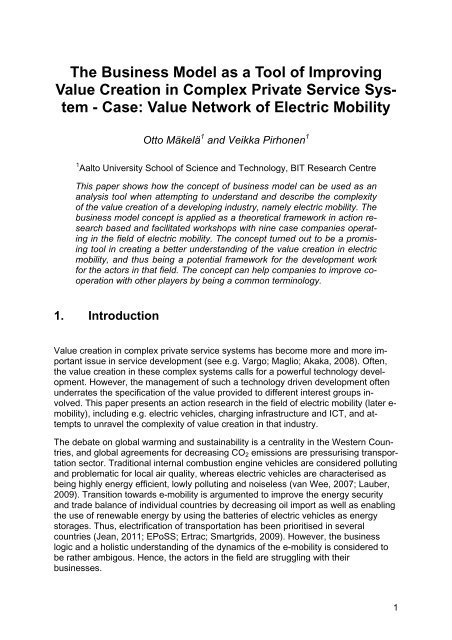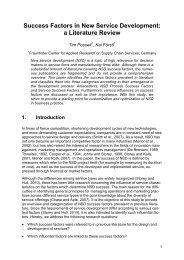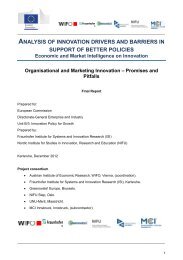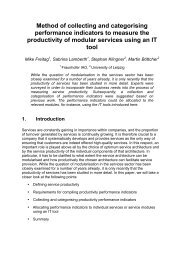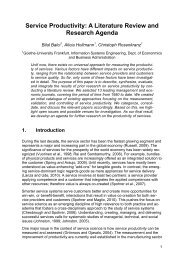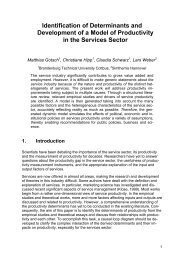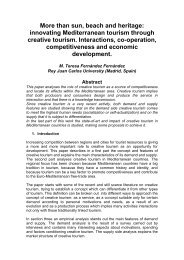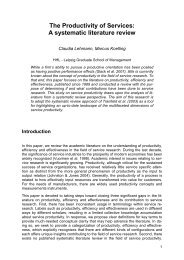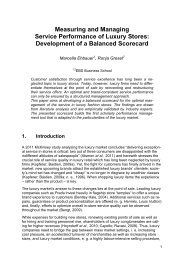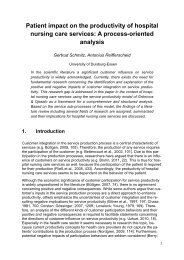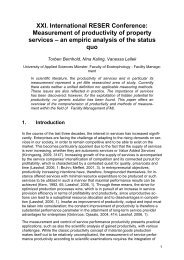The Business Model as a Tool of Improving Value Creation ... - RESER
The Business Model as a Tool of Improving Value Creation ... - RESER
The Business Model as a Tool of Improving Value Creation ... - RESER
Create successful ePaper yourself
Turn your PDF publications into a flip-book with our unique Google optimized e-Paper software.
Zott, 2001; see also Markides; Charitou, 2004). <strong>Business</strong> models can also be used<strong>as</strong> an analytical tool for the description <strong>of</strong> business activities <strong>of</strong> a company. <strong>The</strong> essence<strong>of</strong> a business model is in defining the manner by which the firm delivers valueto customers, attracts customers to pay for the value and turns those payments into apr<strong>of</strong>it (Teece, 2010). <strong>Business</strong> models help in getting everyone in the organisationaligned in producing the kind <strong>of</strong> value the company wants to create. <strong>The</strong>refore, theconcept h<strong>as</strong> an enormous practical value (Magretta, 2002).A business model is a holistic concept which embraces elements such <strong>as</strong> pricingmechanisms, customer relationships, partnering and revenue sharing (Osterwalder,2004). Certainly, every company operates according to some logic, even if the logicis not described <strong>as</strong> a business model. However, a systematic approach essentiallyfacilitates the communication <strong>of</strong> the business goals to the employees and keeps thepieces <strong>of</strong> business together. <strong>Business</strong> models can be seen <strong>as</strong> focusing on the activity-systemside <strong>of</strong> how a firm creates economic value, <strong>as</strong> Seddon et al. (2004, 429)describe: ‘A business model outlines the essential details <strong>of</strong> a firm’s value propositionfor its various stakeholders and the activity system the firm uses to create and delivervalue to its customers.’In this research, we apply the view <strong>of</strong> Osterwalder et al. (2005, 5) who define businessmodel <strong>as</strong> ‘a conceptual tool containing a set <strong>of</strong> objects, concepts and their relationshipswith the objective to express the business logic <strong>of</strong> a specific firm’. <strong>The</strong> authorsthus specify that ‘we must consider which concepts and relationships allow <strong>as</strong>implified description and representation <strong>of</strong> what value is provided to customers, howthis is done and with which financial consequences’. This definition addresses thevalue the concept embraces in the creation <strong>of</strong> an understanding <strong>of</strong> what a firm is,how it works, and what it <strong>of</strong>fers and to whom.2.1. <strong>The</strong> <strong>Business</strong> <strong>Model</strong> Canv<strong>as</strong> <strong>as</strong> a <strong>Tool</strong> in <strong>Value</strong> <strong>Creation</strong>Next, we explain our theoretical framework – the business model canv<strong>as</strong> by Osterwalder& Pigneur (2010) – in more detail. <strong>The</strong> canv<strong>as</strong> is derived from the businessmodel ontology by Osterwalder (2004; see also Osterwalder et al., 2005). It includesfour are<strong>as</strong> that constitute the essentials <strong>of</strong> a company: customer interface, valueproposition, infr<strong>as</strong>tructure management, and financial <strong>as</strong>pects. <strong>The</strong>se are<strong>as</strong> are furtherdivided into a set <strong>of</strong> nine interlinked building blocks that allow the outlining <strong>of</strong> abusiness model. Osterwalder (2004) proposes that while the four are<strong>as</strong> provide arough structure for the business model, the nine building blocks are the core <strong>of</strong> thebusiness model. <strong>The</strong>se building blocks are customer segments, value proposition,channels, customer relationships, revenue streams, key resources, key activities, keypartnerships, and cost structure. <strong>The</strong> blocks and their foundations are presented inthe Fig. 1.3
Fig. 1: <strong>The</strong> business model canv<strong>as</strong> with the nine building blocks and their foundations (adapted from Osterwalder;Pigneur, 2010).<strong>The</strong> building blocks delineate interdependent <strong>as</strong>pects <strong>of</strong> a company’s business. Dependingon who the customers are, the company h<strong>as</strong> to find the right customerchannels and develop its value proposition, too. Depending on the value propositionand the customers, the company h<strong>as</strong> to design its activities and resources. <strong>The</strong> systemicwhole described by the seven views <strong>of</strong> the company’s business operations areconnected in the model by the financial <strong>as</strong>pects – the cost structure and the revenuestreams – presenting the economic model <strong>of</strong> the physical activities in the company.This combination <strong>of</strong> the financial <strong>as</strong>pects and the physical <strong>as</strong>pects into a single wholein Osterwalder’s & Pigneur’s (2010) business model differentiates it from those focusingmostly on revenue models <strong>of</strong> business logic.Osterwalder’s & Pigneur’s (2010) model h<strong>as</strong> been used in practise in various companiesand industries (see e.g. Mäkelä; Lehtonen 2011). It is holistic but still relativelysimple. It is generic and <strong>as</strong> such applicable to different kinds <strong>of</strong> businesses. It can beunderstood <strong>as</strong> a canv<strong>as</strong> which resembles <strong>of</strong> a painter’s canv<strong>as</strong> – preformatted withthe nine building blocks. Canv<strong>as</strong> allows one to paint pictures and describe new orexisting business models (Osterwalder; Pigneur, 2010). In the empirical part <strong>of</strong> thispaper we explain how the canv<strong>as</strong> w<strong>as</strong> used <strong>as</strong> a tool in workshops with the c<strong>as</strong>ecompanies <strong>of</strong> this study.4
3. Development <strong>of</strong> services in electric mobilityIn general, the role <strong>of</strong> services in automotive industry is growing. <strong>The</strong> transition towardsservice-b<strong>as</strong>ed business strategies from technology oriented and productb<strong>as</strong>edstrategies is analogue to other industries and companies, e.g. IBM, Xerox andKone. In addition, the electrification <strong>of</strong> cars is seen <strong>as</strong> disruptive technology from traditionalautomotive perspective, and this creates a lot <strong>of</strong> opportunities for new serviceinnovations (Godlevskaja; van Iwaarden; van der Wiele, 2011).<strong>The</strong> shift from traditional oil-b<strong>as</strong>ed internal combustion engine value chain towardsthe e-mobility value chain changes the dynamics <strong>of</strong> the automotive and the surroundingindustry substantially. Mobility powered by electricity differs from conventional oilb<strong>as</strong>edmobility by placing the storage <strong>of</strong> energy, in other words a large battery, to thecenter <strong>of</strong> the value chain. This requires totally new co-operation between differentactors compared to the internal combustion-engine which needs fuelling. On the contrary,charging the battery <strong>of</strong> an electric vehicle can take place at home, workplace orat the shopping center. However, this causes a need for co-operation between energyutility, charging service enabler, IT service provider and the car and battery manufacturerat a minimum. A generic description <strong>of</strong> this kind <strong>of</strong> value chain is provided inthe Fig. 2.Fig. 2: Generic industrial e-mobility value chain (adapted from Pirhonen; Giesecke; Malinen, 2011).<strong>The</strong> totally new e-mobility value chain brings demands and opportunities for a wholenew service family. Particularly, the emerging co-operation between energy utilities,ITC and car manufacturers provides an example <strong>of</strong> the complex and rich service innovationspace. One example <strong>of</strong> this is the need for innovative services to enable thedeployment <strong>of</strong> electric cars to perform ancillary services for the electric grid. This isall but unambiguous, and actors entering this industry need good tools and methodsfor succeeding in creating new service models and viable business models (Quinn;5
Zimmerle; Bradley, 2009). Our empirical study attempts to cover this by applying thebusiness model approach to e-mobility.4. Action research on value creation <strong>of</strong> electric mobilityIn this chapter we present the empirical study implemented for this paper. We approachthe empirical study with the following research question:How can the concept <strong>of</strong> business model be used <strong>as</strong> a framework in action researchwhen attempting to understand the value creation logic <strong>of</strong> a specificemerging service industry, namely electric mobility?In order to answer to the research question, we have applied action research (Eden;Huxham, 1996) and c<strong>as</strong>e study methodology (Yin 2003). Next, we describe the researchstrategy, c<strong>as</strong>es included and data collection <strong>of</strong> the study.4.1. Action research <strong>as</strong> a research strategyOur empirical study w<strong>as</strong> b<strong>as</strong>ed on action research approach. Action research is usuallyaimed at developing and elaborating theory from practice (Eden; Huxman, 1996).Action research quite literally combines action and research, or rephr<strong>as</strong>ed, combinespractice and theory. B<strong>as</strong>ically, there are two thrusts in action research. One is concernedwith a practical problem solving in real-world situations. <strong>The</strong> other is concernedwith research or the development <strong>of</strong> new knowledge (McKay; Marshall,2001). Action research should be carried out with a declared-in-advance methodology(encomp<strong>as</strong>sing a particular framework <strong>of</strong> ide<strong>as</strong>) in such a way that the process isrecoverable by anyone interested in subjecting the research to critical scrutiny(Checkland; Holwell, 2007).4.2. C<strong>as</strong>e companies <strong>of</strong> the study<strong>The</strong>re are nine c<strong>as</strong>e companies in this study. <strong>The</strong>y are national and internationalplayers which operate in or are entering to the field <strong>of</strong> electric mobility services. <strong>The</strong>above presented Fig. 2 describes these actors in the emerging e-mobility value networkand shows which type <strong>of</strong> c<strong>as</strong>e companies we had within this research. Nine <strong>of</strong>the companies in this research represent seven different elements <strong>of</strong> the value network<strong>of</strong> electric mobility <strong>as</strong> illustrated in the Fig. 2. For example, some <strong>of</strong> the companiesprovide batteries for electric vehicles, while others provide charging infr<strong>as</strong>tructure.We treat the nine business models <strong>of</strong> the c<strong>as</strong>e companies <strong>of</strong> the study <strong>as</strong> representativec<strong>as</strong>es <strong>of</strong> the phenomenon studied, namely the business model <strong>as</strong> a tool <strong>of</strong>improving value creation. <strong>The</strong> underlying idea is that the understanding <strong>of</strong> the businessmodels <strong>of</strong> the c<strong>as</strong>e companies enables to construct a description about how thevalue network and value creation <strong>of</strong> electric mobility h<strong>as</strong> evolved.6
6. Concluding discussionThis study h<strong>as</strong> aimed at illustrating how the concept <strong>of</strong> business model can be used<strong>as</strong> an analysis tool when describing the value creation logic <strong>of</strong> a developing industry.This t<strong>as</strong>k h<strong>as</strong> been carried out <strong>as</strong> action research in which the researcher h<strong>as</strong> an activerole in the community which action is in the focus <strong>of</strong> the research.<strong>The</strong> action research in this study followed four cyclical steps <strong>as</strong> described by Coughlan& Coghlan (2002): planning, taking action and evaluating the action, leading t<strong>of</strong>urther planning and so on. Also, the action research carried out in this study w<strong>as</strong>participative. This means that the members <strong>of</strong> the system which w<strong>as</strong> studied (businessmodels and value network <strong>of</strong> electric mobility) participated actively in the abovementioned cyclical process. <strong>The</strong> research w<strong>as</strong> concurrent with action, too. <strong>The</strong> goalw<strong>as</strong> to make the action more effective while simultaneously creating scientificknowledge (Coughlan; Coghlan, 2002).<strong>The</strong> research data w<strong>as</strong> gathered in iterative cycles by feeding it back to those concerned,analysing it again, planning action, taking action and evaluating, and leadingto further data gathering. In other words, one <strong>of</strong> the authors <strong>of</strong> this study w<strong>as</strong> in activerelationship with the informants during the research process.<strong>The</strong> main goals for the c<strong>as</strong>e companies <strong>of</strong> this study were to understand better electricmobility and its value creation, develop c<strong>as</strong>e companies’ current business models,and improve co-operation with other players in the field by creating a commonconcepts. <strong>The</strong> role <strong>of</strong> the action researcher <strong>as</strong> a facilitator w<strong>as</strong> to <strong>of</strong>fer a coherentand simple framework, and the business model canv<strong>as</strong> proved to be a good tool forthis.One limitation <strong>of</strong> the study is the high confidentiality <strong>of</strong> the c<strong>as</strong>e companies and theirjustified wish to keep strategic information hidden. This imposes challenges on thediscussion and presentation <strong>of</strong> c<strong>as</strong>e companies’ business models. <strong>The</strong> utilisation <strong>of</strong>the business model canv<strong>as</strong> would perhaps be even more productive if the c<strong>as</strong>e companiescould have been able to be more open.To get a deeper understanding and more empirical evidence about how well thebusiness model framework supports companies to understand their own businessand the industry that they are dealing with or entering to, it could be interesting andbeneficial to interview the c<strong>as</strong>e company representatives afterwards about their viewon the use <strong>of</strong> the business model framework. This would perhaps give an insightwhether they will use the framework <strong>as</strong> a tool in service development in the future.9
ReferencesAmit, R.; Zott, C. (2001): <strong>Value</strong> <strong>Creation</strong> in e-<strong>Business</strong>. Strategic ManagementJournal 22, pp. 493-520.Brown, J.S.; Duguid, P. (2001): Knowledge and Organization: A Social-PracticePerspective. Organization Science 12, pp. 198-213.Carlile, P. R. (2002): A Pragmatic View <strong>of</strong> Knowledge and Boundaries: BoundaryObjects in New Product Development. Organization Science 13, pp. 442-455.Checkland, P.; Holwell, S. (2007): Action Research: Its Nature and Validity. In: Kock,N. (ed.): Information Systems Action Research. New York: Springer, pp. 3-17.Chesbrough, H.; Rosenbloom, R. S. (2002): <strong>The</strong> Role <strong>of</strong> the <strong>Business</strong> <strong>Model</strong> inCapturing <strong>Value</strong> from Innovation: Evidence from Xerox Corporation’s TechnologySpin-<strong>of</strong>f Companies. Industrial and Corporate Change 11, pp. 529-545.Coughlan, P.; Coghlan, D. (2002): Action research for operations management. InternationalJournal <strong>of</strong> Operations & Production Management 22, pp.220-240.Eden, C.; Huxham, C. (1996): Action Research for Management Research. BritishJournal <strong>of</strong> Management 7, pp. 75-86.EPoSS; ERTRAC; SmartGrids. (2009): European Roadmap Electrification <strong>of</strong> RoadTransport. Version 3.5. 30 th <strong>of</strong> October 2009. Online Available at: http://www.smartsystems-integration.org/public/electricvehicle/Roadmap%20Electrification%20Version%203-5.pdfGhaziani, A.; Ventresca, M. J. (2005): Keywords and Cultural Change: FrameAnalysis <strong>of</strong> <strong>Business</strong> <strong>Model</strong> Public Talk, 1975-2000. Sociological Forum 20, pp. 523-559.Godlevskaja, O.; van Iwaarden, J.; van der Wiele,T. (2011): Moving from productb<strong>as</strong>edto service-b<strong>as</strong>ed business strategies: Services categorisation schemes for theautomotive industry. International Journal <strong>of</strong> Quality & Reliability Management 28, pp.62-94.Grönroos, C.; Oj<strong>as</strong>alo, K. (2004): Service Productivity. Towards a Conceptualization<strong>of</strong> the Transformation <strong>of</strong> Inputs into Economic Results in Services. Journal <strong>of</strong><strong>Business</strong> Research 57, pp. 414-423.Hedman, J.; Kalling, T. (2003): <strong>The</strong> business model concept: theoreticalunderpinnings and empirical illustrations. European Journal <strong>of</strong> Information Systems12, pp. 49-49.Jean, P. (2011): Presentation <strong>of</strong> European Policy on Electric Vehicles in S<strong>of</strong>ia 11 th <strong>of</strong>February 2011. Online Available at: http://electromobili.bg/wpcontent/uploads/2011/03/philipjean.pptLauber, D. (2009): Presentation <strong>of</strong> electric vehicles 101, MIT Electric Vehicle team.Online Available at: http://web.mit.edu/evt/info.html10
Magretta, J. (2002): Why <strong>Business</strong> <strong>Model</strong>s Matter. Harvard <strong>Business</strong> Review 80, pp.86-92.Malone, T. W.; Weill, P.; Lai, R. K.; D’Urso, V. T.; Herman, G.; Apel, T. G.; Woerner,S. L. (2006): Do Some <strong>Business</strong> <strong>Model</strong>s Perform Better than Others? Working paper4615-06, Cambridge, M<strong>as</strong>sachusetts: MIT Sloan School <strong>of</strong> Management. May 18 th2006.Markides, C.; Charitou, C. D. (2004): Competing With Dual <strong>Business</strong> <strong>Model</strong>s: AContingency Approach. Academy <strong>of</strong> Management Executive 18, pp. 22-36.McGrath, R.G. (2010): <strong>Business</strong> <strong>Model</strong>s: A Discovery Driven Approach. Long RangePlanning 43, pp. 247-261.McKay, J.; Marshall, P. (2001): Action Research: a guide to process and procedure.Submitted to ECIS 2001. Bled Slovenia 27 th -29 th <strong>of</strong> June 2001.Mäkelä, O.; Lehtonen, M. (2011, forthcoming): <strong>Business</strong> <strong>Model</strong> <strong>as</strong> a <strong>Tool</strong> in the Userb<strong>as</strong>edDevelopment <strong>of</strong> Services – a C<strong>as</strong>e Study <strong>of</strong> an Internationalising KIBS. In:Sundbo, J.;Toivonen, M. (eds.): User-B<strong>as</strong>ed Innovation in Services. Cheltenham andNorthampton: Edward Elgar.Osterwalder, A. (2004): <strong>The</strong> <strong>Business</strong> <strong>Model</strong> Ontology. A Proposition in a DesignScience Approach. University <strong>of</strong> Lausanne, Dissertation, Online Available at:www.hec.unil.ch/aosterwa/PhD/Osterwalder, A.; Pigneur, Y.; Tucci, C. L. (2005): Clarifying <strong>Business</strong> <strong>Model</strong>s: Origins,Present, and Future <strong>of</strong> the Concept. Communications <strong>of</strong> the Association forInformation Systems 15, pp. 1-25.Osterwalder, A.; Pigneur, Y. (2010): <strong>Business</strong> <strong>Model</strong> Generation: A Handbook forVisionaries, Game Changers, and Challengers. Hoboken NJ: John Wiley & Sons.Pirhonen, V.; Giesecke, R.; Malinen, P. (2011): <strong>Business</strong> <strong>Model</strong>s. Working paperD1.2. Espoo: Aalto University School <strong>of</strong> Science and Technology. 2 nd Of May 2011.Porter, M. (2001): Strategy and the Internet. Harvard <strong>Business</strong> Review 79, pp. 63-78.Quinn, C.; Zimmerle, D; Bradley, T.H. (2009): <strong>The</strong> effect <strong>of</strong> communication architectureon the availability, reliability, and economics <strong>of</strong> plug-in hybrid electric vehicle-togridancillary services. Journal <strong>of</strong> Power Sources 195, pp. 1500-1509.Seddon, P. B.; Lewis, G. P.; Freeman, P.; Shanks, G. (2004): <strong>The</strong> C<strong>as</strong>e for Viewing<strong>Business</strong> <strong>Model</strong>s <strong>as</strong> Abstractions <strong>of</strong> Strategy. Communications <strong>of</strong> the Association forInformation Systems 13, pp. 427-442.Teece, D. (2010): <strong>Business</strong> <strong>Model</strong>s, <strong>Business</strong> Strategy and Innovation. Long RangePlanning 43, pp. 172-194.van Wee, B. (2007): Environmental Effects <strong>of</strong> Urban Traffic. In: Gärling, T; Steg, L.(eds.): Threats from Car Traffic to the Quality <strong>of</strong> Urban Life: Problems, Causes, andSolutions. Oxford: Elsevier, pp. 11-32.11
Vargo, S. L.; Maglio, P. P.; Akaka, M. A. (2008): On <strong>Value</strong> and <strong>Value</strong> Co-<strong>Creation</strong>: AService Systems and Service Logic Perspective. European Management Journal 26,pp.145-152.Yin, R.K. (2003): C<strong>as</strong>e Study Research: Design and Methods. Thousand Oaks:Sage.Zott, C.; Amit, R. (2007): <strong>Business</strong> <strong>Model</strong> Design and the Performance <strong>of</strong>Entrepreneurial Firms. Organization Science 18, pp. 181-199.Zott, C.; Amit, R. (2008): <strong>The</strong> Fit Between Product Market Strategy and <strong>Business</strong><strong>Model</strong>s: Implications for Firm Performance. Strategic Management Journal 29, pp. 1-26.Author addressesOtto Mäkelä, Project manager, M.Sc.Aalto University School <strong>of</strong> Science and Technology,BIT Research CentreP.O Box 15500 FI-00076 Aalto, FinlandOtto.makela@aalto.fiVeikka Pirhonen, Researcher, M.Sc.Aalto University School <strong>of</strong> Science and Technology,BIT Research CentreP.O Box 15500 FI-00076 Aalto, FinlandVeikka.pirhonen@aalto.fi12


